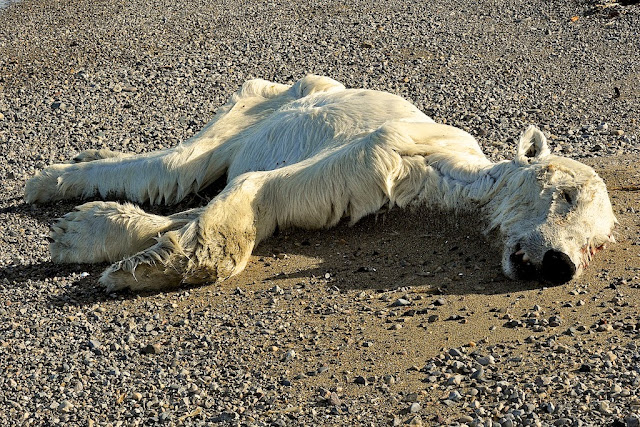
Saturday, December 30, 2017
Saturday, December 23, 2017
Merry Christmas
Nanook and friends of the planet
Monday, December 18, 2017
Friday, December 8, 2017
Why the fight to stop Keystone XL is far from over
by Tim Donaghy November 22, 2017
This week Nebraska's Public Service Commission approved an alternate route for the Keystone XL pipeline. But that decision wasn't what the pipeline builder was hoping for -- and it shows that continued resistance will be crucial to defeating this pipeline for good.
© Amber Bracken / Greenpeace
This Monday the Nebraska Public Service Commission approved an alternate route for TransCanada’s proposed Keystone XL tar sands pipeline, and denied the company’s preferred route. The pipeline should have been rejected outright, but as the company’s grimly muted response shows, this decision by the PSC wasn’t the good news TransCanada had been hoping for.
The Keystone XL pipeline now faces significant legal, financial, and regulatory hurdles, a growing resistance movement on the ground, as well as a number of banks backing away from funding such risky and destructive projects.
With everything in front of TransCanada it’s hard to see an easy path forward for the company.
Let’s break it down.
Tell It To The Judge
Legal challenges to the Keystone XL pipeline had already started piling up before Monday’s decision.
Earlier this year environmental and grassroots groups filed suit to challenge Trump’s approval because the administration relied on an outdated and incomplete Environmental Impact Statement (EIS) that dated back to 2014. Monday’s decision may strengthen those arguments because the outdated EIS is based on a different route than what was ultimately approved, meaning that some environmental impacts may not have been properly studied. To give one example, the new route could impact new threatened and endangered species, including the pallid sturgeon.
https://twitter.com/Ed_Crooks/status/933051370168553472
The U.S. State Department has said it is reviewing the PSC decision and just today a federal judge ruled that this lawsuit can proceed, raising the possibility that further environmental reviews may be ordered before Keystone XL can move ahead.
Similarly, Dakota Rural Action, the Intertribal Council on Utility Policy, and the Yankton Sioux Tribe are involved in legal action against the state of South Dakota, which had previously approved the pipeline in that state.
Finally, groups could choose to file an appeal against the Nebraska PSC decision itself in the next 30 days.
Re-routing the pipeline could also lead to new legal headaches for TransCanada. Landowners along the new pipeline route may not have had sufficient opportunity to comment on the alternate route, and new objections and disputes could arise. TransCanada will likely need to secure agreements with these new landowners or could be required to file eminent domain petitions to proceed with construction.
As a lawyer for the Sierra Club put it, “this decision opens up a whole new bag of (legal) issues that we can raise.” Navigating these various hurdles could be a very lengthy and potentially costly process.
No Keystone XL Pipeline
Just this week in South Dakota on the Lower Brule Reservation of the Kul Wicasa Oyate, representatives of Tribal Nations gathered for the second signing of the Treaty to Protect the Sacred from tar sands. See the livestream here.
From that important gathering, a handful of groups, including Greenpeace USA, launched the “Promise to Protect”– a promise to keep the movement against this tar sands pipeline going with peaceful, creative resistance.
The Ponca Tribe of Nebraska has worked with a coalition of allies to plant Ponca Sacred Corn in the path of the proposed pipeline, and near the Ponca Trail of Tears. Similarly, at multiple locations along the pipeline route, families have built solar power arrays in its path as a concrete reminder that clean energy is a viable alternative to dirty tar sands and have plans for more.
TransCanada’s recent 200,000+ gallon spill from its existing Keystone 1 pipeline in South Dakota highlights why so many have pledged to stand against these pipelines.
This resistance is part of a growing movement opposed to the further expansion of risky and unnecessary fossil fuel infrastructure. Three proposed pipelines carrying tar sands from Alberta to ports and refineries have drawn particular opposition. Already over 150 First Nations and Tribes have declared their opposition to tar sands pipelines, rail and tanker traffic through their traditional territories and waters.
Enbridge’s proposed Line 3 expansion still has not secured final regulatory approval but has already sparked protest encampments and resistance. Kinder Morgan’s Trans Mountain pipeline which was proposed to carry tar sands bitumen from Alberta to Canada’s west coast has been greeted by the construction of tiny houses along its path, built by members of the Secwepmc Nation.
Banks Think Twice About Lending to Destructive Projects
The PSC decision was seen by some financial analysts as a sign of uncertainty for the project. Moody’s Investors Service stated that the decision “does not provide certainty that the project will ultimately be built and begin operating” and that pipeline construction “would negatively affect TransCanada’s business risk profile.”
A recent report from Greenpeace and Oil Change International, In The Pipeline, outlined the significant risks to banks and investors of these three tar sands pipelines. Major risks include:
Reputational risks from projects that could violate the human rights of indigenous communities, and that have proceeded without obtaining the Free, Prior and Informed Consent of communities impacted by the pipelines.
Reputational and financial risks from projects that pose a threat to local environments from pipeline oil spills and potential contamination of water resources. In addition to last week’s Keystone spill, a recent report from Greenpeace found that the three companies proposing to build these pipelines, and their subsidiaries, have been responsible for at least 373 spills releasing over 60,000 barrels of hazardous liquids since 2010.
Undermining other actions on climate change by bankrolling projects that are flatly inconsistent with the goals of the Paris climate accords and a healthy climate. These proposed pipelines are key to unlocking up to 2 million additional barrels per day of tar sands, one of the most environmentally destructive energy sources on the planet.
Questions over the economic viability of the pipelines. The expansion of the tar sands is also dependent on high future oil prices that may not materialize. China and a number of other countries have announced policies that could significantly reduce the demand for oil over the next decades.
In recent months a number of banks, including BNP Paribas (the 8th largest bank in the world), ING Bank, and US Bank have adopted policies to eliminate financial support for tar sands pipelines. Greenpeace has called on JPMorgan Chase to do the same. Twenty-five banks currently provide key financial services that allow these projects to proceed.
All of this shows that organized, people-powered resistance can beat powerful and wealthy corporations. The resistance to KXL is working, but we need to fight even harder to cancel this pipeline for good. Join the #PromiseToProtect and plug into a massive wave of creative resistance to stop the pipeline.
Tim Donaghy is a Senior Research Specialist with Greenpeace USA. He writes frequently about climate change, offshore oil drilling, energy production, and the Arctic.
This week Nebraska's Public Service Commission approved an alternate route for the Keystone XL pipeline. But that decision wasn't what the pipeline builder was hoping for -- and it shows that continued resistance will be crucial to defeating this pipeline for good.
© Amber Bracken / Greenpeace
This Monday the Nebraska Public Service Commission approved an alternate route for TransCanada’s proposed Keystone XL tar sands pipeline, and denied the company’s preferred route. The pipeline should have been rejected outright, but as the company’s grimly muted response shows, this decision by the PSC wasn’t the good news TransCanada had been hoping for.
The Keystone XL pipeline now faces significant legal, financial, and regulatory hurdles, a growing resistance movement on the ground, as well as a number of banks backing away from funding such risky and destructive projects.
With everything in front of TransCanada it’s hard to see an easy path forward for the company.
Let’s break it down.
Tell It To The Judge
Earlier this year environmental and grassroots groups filed suit to challenge Trump’s approval because the administration relied on an outdated and incomplete Environmental Impact Statement (EIS) that dated back to 2014. Monday’s decision may strengthen those arguments because the outdated EIS is based on a different route than what was ultimately approved, meaning that some environmental impacts may not have been properly studied. To give one example, the new route could impact new threatened and endangered species, including the pallid sturgeon.
https://twitter.com/Ed_Crooks/status/933051370168553472
The U.S. State Department has said it is reviewing the PSC decision and just today a federal judge ruled that this lawsuit can proceed, raising the possibility that further environmental reviews may be ordered before Keystone XL can move ahead.
Similarly, Dakota Rural Action, the Intertribal Council on Utility Policy, and the Yankton Sioux Tribe are involved in legal action against the state of South Dakota, which had previously approved the pipeline in that state.
Finally, groups could choose to file an appeal against the Nebraska PSC decision itself in the next 30 days.
Re-routing the pipeline could also lead to new legal headaches for TransCanada. Landowners along the new pipeline route may not have had sufficient opportunity to comment on the alternate route, and new objections and disputes could arise. TransCanada will likely need to secure agreements with these new landowners or could be required to file eminent domain petitions to proceed with construction.
As a lawyer for the Sierra Club put it, “this decision opens up a whole new bag of (legal) issues that we can raise.” Navigating these various hurdles could be a very lengthy and potentially costly process.
Ground Resistance
Despite this approval, ground resistance to this pipeline continues to grow. The chairman of the Cheyenne River Sioux Tribe, Harold Frazier, stated that his tribe “will fight this treaty violation with any means necessary. […] We have not asked for this danger to our way of life, yet today it is being forced upon us again.”No Keystone XL Pipeline
Just this week in South Dakota on the Lower Brule Reservation of the Kul Wicasa Oyate, representatives of Tribal Nations gathered for the second signing of the Treaty to Protect the Sacred from tar sands. See the livestream here.
From that important gathering, a handful of groups, including Greenpeace USA, launched the “Promise to Protect”– a promise to keep the movement against this tar sands pipeline going with peaceful, creative resistance.
The Ponca Tribe of Nebraska has worked with a coalition of allies to plant Ponca Sacred Corn in the path of the proposed pipeline, and near the Ponca Trail of Tears. Similarly, at multiple locations along the pipeline route, families have built solar power arrays in its path as a concrete reminder that clean energy is a viable alternative to dirty tar sands and have plans for more.
TransCanada’s recent 200,000+ gallon spill from its existing Keystone 1 pipeline in South Dakota highlights why so many have pledged to stand against these pipelines.
This resistance is part of a growing movement opposed to the further expansion of risky and unnecessary fossil fuel infrastructure. Three proposed pipelines carrying tar sands from Alberta to ports and refineries have drawn particular opposition. Already over 150 First Nations and Tribes have declared their opposition to tar sands pipelines, rail and tanker traffic through their traditional territories and waters.
Enbridge’s proposed Line 3 expansion still has not secured final regulatory approval but has already sparked protest encampments and resistance. Kinder Morgan’s Trans Mountain pipeline which was proposed to carry tar sands bitumen from Alberta to Canada’s west coast has been greeted by the construction of tiny houses along its path, built by members of the Secwepmc Nation.
Banks Think Twice About Lending to Destructive Projects
The PSC decision was seen by some financial analysts as a sign of uncertainty for the project. Moody’s Investors Service stated that the decision “does not provide certainty that the project will ultimately be built and begin operating” and that pipeline construction “would negatively affect TransCanada’s business risk profile.”
A recent report from Greenpeace and Oil Change International, In The Pipeline, outlined the significant risks to banks and investors of these three tar sands pipelines. Major risks include:
Reputational risks from projects that could violate the human rights of indigenous communities, and that have proceeded without obtaining the Free, Prior and Informed Consent of communities impacted by the pipelines.
Reputational and financial risks from projects that pose a threat to local environments from pipeline oil spills and potential contamination of water resources. In addition to last week’s Keystone spill, a recent report from Greenpeace found that the three companies proposing to build these pipelines, and their subsidiaries, have been responsible for at least 373 spills releasing over 60,000 barrels of hazardous liquids since 2010.
Undermining other actions on climate change by bankrolling projects that are flatly inconsistent with the goals of the Paris climate accords and a healthy climate. These proposed pipelines are key to unlocking up to 2 million additional barrels per day of tar sands, one of the most environmentally destructive energy sources on the planet.
Questions over the economic viability of the pipelines. The expansion of the tar sands is also dependent on high future oil prices that may not materialize. China and a number of other countries have announced policies that could significantly reduce the demand for oil over the next decades.
In recent months a number of banks, including BNP Paribas (the 8th largest bank in the world), ING Bank, and US Bank have adopted policies to eliminate financial support for tar sands pipelines. Greenpeace has called on JPMorgan Chase to do the same. Twenty-five banks currently provide key financial services that allow these projects to proceed.
All of this shows that organized, people-powered resistance can beat powerful and wealthy corporations. The resistance to KXL is working, but we need to fight even harder to cancel this pipeline for good. Join the #PromiseToProtect and plug into a massive wave of creative resistance to stop the pipeline.
Tim Donaghy is a Senior Research Specialist with Greenpeace USA. He writes frequently about climate change, offshore oil drilling, energy production, and the Arctic.
Tuesday, December 5, 2017
Scientists express shame and anger at plastic pollution of oceans

Wandering albatrosses scour the oceans for food to bring back to their chicks
Scientists who advised and consulted with the Blue Planet II documentary team say they feel "shame and anger" at the “plague of plastic” impacting the natural world.
Even in the remote waters of Antarctica, they have found evidence of plastic killing and harming seabirds. Wandering albatrosses – which have the longest wingspan of any birds alive today – are thought to be especially vulnerable.
Nesting on the barren islands of South Georgia, Antarctica, they feed their young by scouring thousands of miles of ocean for squid and fish but often bring back plastic instead and feed it to their young. The final episode of what has become one of the most-watched TV programs of the year explores how the oceans are threatened by human activities including overfishing and pollution.
It will be broadcast on Sunday 10 December on BBC.
Even in the remote waters of Antarctica, they have found evidence of plastic killing and harming seabirds. Wandering albatrosses – which have the longest wingspan of any birds alive today – are thought to be especially vulnerable.
Nesting on the barren islands of South Georgia, Antarctica, they feed their young by scouring thousands of miles of ocean for squid and fish but often bring back plastic instead and feed it to their young. The final episode of what has become one of the most-watched TV programs of the year explores how the oceans are threatened by human activities including overfishing and pollution.
It will be broadcast on Sunday 10 December on BBC.
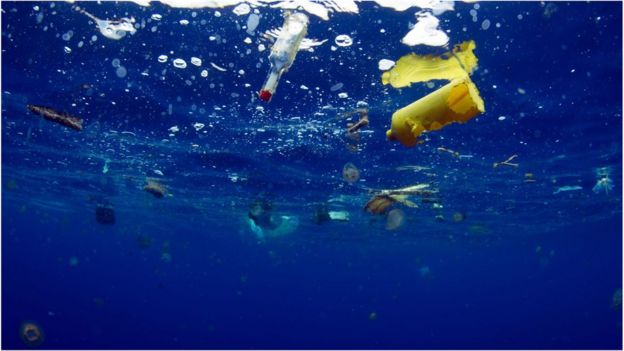
The final program in the series will look at some of the threats facing the oceans
In a particularly moving scene, Dr Lucy Quinn, a zoologist, is seen checking albatross chicks on Bird Island where she was the British Antarctic Survey’s winter manager for more than two years.
One chick that Dr Quinn found dead and later dissected was killed because a plastic toothpick that it swallowed had pierced its stomach.
Others had regurgitated plastic items including cling film, food packaging, cutlery and parts of bottles.
Dr Quinn reported, “I feel real shame and anger that humans have caused this problem.
"It’s really sad because you get to know the birds and how long it takes the parents, away for ten days at a time, to collect food for their chicks and what they bring back is plastic.
"And what’s sad is that the plague of plastic is as far-reaching as these seemingly pristine environments."
One chick that Dr Quinn found dead and later dissected was killed because a plastic toothpick that it swallowed had pierced its stomach.
Others had regurgitated plastic items including cling film, food packaging, cutlery and parts of bottles.
Dr Quinn reported, “I feel real shame and anger that humans have caused this problem.
"It’s really sad because you get to know the birds and how long it takes the parents, away for ten days at a time, to collect food for their chicks and what they bring back is plastic.
"And what’s sad is that the plague of plastic is as far-reaching as these seemingly pristine environments."
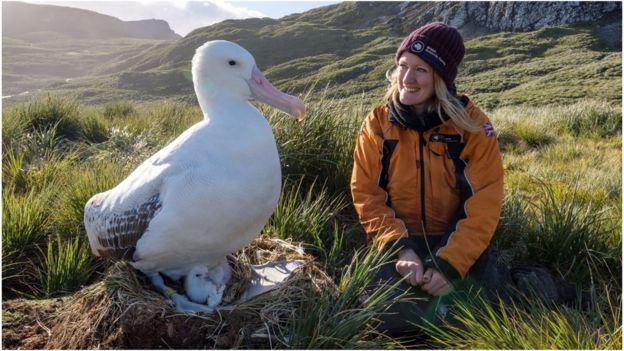
Lucy Quinn seen checking albatrosses on Bird Island, part of South Georgia
It's not known how many albatross chicks in Antarctica die from plastic pollution every year – it's thought to be fewer than the losses suffered by Laysan albatrossesin the Pacific .
But on Bird Island, predators often eat dead chicks before the researchers can reach them – and the suspicion is that the effect of the plastic goes beyond the direct killing of seabirds. It causes health risks to the predators too.
According to Dr Quinn, the threat is more insidious, weakening birds as they waste energy trying to digest plastic, which has no nutritional value, and potentially poisoning them as chemicals are released when the plastic breaks down in their stomachs.
Research at the other end of the world into a smaller relative of the albatross – the fulmars of the North Sea – shows that while plastics may directly kill seabirds, it is the debilitating effects of the waste that could be more serious.
But on Bird Island, predators often eat dead chicks before the researchers can reach them – and the suspicion is that the effect of the plastic goes beyond the direct killing of seabirds. It causes health risks to the predators too.
According to Dr Quinn, the threat is more insidious, weakening birds as they waste energy trying to digest plastic, which has no nutritional value, and potentially poisoning them as chemicals are released when the plastic breaks down in their stomachs.
Research at the other end of the world into a smaller relative of the albatross – the fulmars of the North Sea – shows that while plastics may directly kill seabirds, it is the debilitating effects of the waste that could be more serious.

If a human had ingested the equivalent plastic volume as the average fulmar does (L), it would fill a lunchbox (R)
Studies of fulmars found dead on beaches or caught accidentally by fishermen – which Dr Quinn has also been involved in – show that from 2010-2014, fulmars were found to contain on average 39 particles of plastic weighing a total of 0.32 grams.
In an unsettling image, the volume of space taken up by that plastic in a fulmar’s belly is the equivalent in a human stomach of the contents of a typical lunchbox, and usually the plastic is made up of consumer items used just once and then thrown away.
Most shocking is the effect of party balloons, released in a moment of celebration, but then catching the eye of a fulmar searching for food. Dr Quinn remembers one occasion when she dissected one of the birds.
"I couldn’t believe my eyes, seeing a balloon in the bird’s oesophagus, which would have killed it, along with cling wrap, toothbrushes and packaging – I feel extremely sad for the birds; frustrated and impatient to do something," she said.
The plastic is undermining the fulmars’ health, which could affect their ability to breed - with long-term implications for the species as a whole.
Studies of fulmars found dead on beaches or caught accidentally by fishermen – which Dr Quinn has also been involved in – show that from 2010-2014, fulmars were found to contain on average 39 particles of plastic weighing a total of 0.32 grams.
In an unsettling image, the volume of space taken up by that plastic in a fulmar’s belly is the equivalent in a human stomach of the contents of a typical lunchbox, and usually the plastic is made up of consumer items used just once and then thrown away.
Most shocking is the effect of party balloons, released in a moment of celebration, but then catching the eye of a fulmar searching for food. Dr Quinn remembers one occasion when she dissected one of the birds.
"I couldn’t believe my eyes, seeing a balloon in the bird’s oesophagus, which would have killed it, along with cling wrap, toothbrushes and packaging – I feel extremely sad for the birds; frustrated and impatient to do something," she said.
The plastic is undermining the fulmars’ health, which could affect their ability to breed - with long-term implications for the species as a whole.

The Cayman Trough: Plastic debris has descended to the deepest parts of the world's oceans
The threat from plastic waste is not limited to pieces that are visible – bottles, bags and other items break down into minute fragments, or "micro-plastics", which enter the food chain in every corner of the ocean.
Scientists from the University of Newcastle even identified tiny fibres in the smallest creatures living in the deepest part of the Pacific, the Mariana Trench.
Scientists from the University of Newcastle even identified tiny fibres in the smallest creatures living in the deepest part of the Pacific, the Mariana Trench.
Dr Jon Copley, of the University of Southampton, who joined the Blue Planet submarine filming in Antarctica, said, "When I've seen plastic in the deep ocean - such as a trash bin liner we found near deep-sea vents in the Cayman Trough - there's an initial shock and then deep disappointment that our garbage got here before we did as explorers."
"But then there's the realization that our everyday lives are more connected to the deep ocean than we perhaps think.
"Every piece of plastic rubbish has a story, so it also makes me wonder about the chain of events that led to that particular item ending up in the deep ocean, and whether any of those events could have been prevented."
Saturday, December 2, 2017
NASA links port-city sea levels to regional ice melt
The contribution of melting ice in Greenland to sea level rise in New York City (inset). Red indicates the greatest sea level contribution, blue is the smallest to no contribution. A new NASA tool lets users research the contributions of all regions of global land ice to sea levels in 293 port cities. Data image credit: NASA/JPL-Caltech/Google. Photo credit: Wikimedia Commons.
By Pat Brennan,
NASA's Sea Level Change Portal
A new NASA tool links changes in sea level in 293 global port cities to specific regions of melting land ice, such as southern Greenland and the Antarctic Peninsula. It is intended to help coastal planners prepare for rising seas in the decades to come.
All coastal cities will see some impacts of global sea level rise. But the new tool shows that, for example, New York City is more strongly affected by melting ice in northeastern Greenland than in southwestern Greenland; while Sydney has a greater risk from the rapidly melting Antarctic Peninsula than from East Antarctica.
A paper describing the new tool, titled "Should coastal planners have concern over where land ice is melting?," was recently published in the journal Science Advances. The research team is Eric Larour, Erik Ivins and Surendra Adhikari of NASA's Jet Propulsion Laboratory in Pasadena, California.
Melting ice and rising ocean temperatures contribute about evenly to global sea level rise today. Individual cities are also affected by local conditions such as land sinking. Other Web-based resources such as the U.S. Climate Resilience Toolkit address some of these issues, but the new NASA tool is the only resource to match specific melting ice locations with their effects on the world's ports.
Water from melted ice on land doesn't spread evenly across the world's oceans because of a gravitational push-pull between ice and ocean. As a melting glacier or ice sheet dwindles, it loses mass, causing its local gravitational pull on nearby ocean water to diminish. Seawater that had been pulled toward the ice by the force of gravity flows away — in other words, sea level drops in the vicinity of a melting glacier but rises farther away. When this spatial pattern can be attributed to a given glacier or ice sheet, it is known as a sea level fingerprint.
To calculate this and other influences on sea level such as Earth's rotation, Larour and his colleagues used a dynamic mathematical formula called the adjoint method, which is used in seismic and meteorological studies. The method enables fast computation of the sensitivity of a model's output to its inputs — in this case, the sensitivity of sea level to ice melting. They used the method with JPL's well-tested computer model of ice sheet melting, the Ice Sheet System Model, to develop their new tool, called Gradient Fingerprint Mapping.
Users of the tool need no specialized training or extreme computer power; they simply download it, input data or projections of ice loss, and let it evolve the shifting ice and water patterns forward into the future. The result: a detailed profile of the sensitivity of sea level at any of these cities to changes in ice anywhere in the world.
Calculations of sea level fingerprints have been made in previous studies but tended to be cumbersome and spatially coarse, Larour said. The new tool provides an overall mechanism for rapidly computing high-resolution results using a variety of potential data sets.
Gradient Fingerprint Mapping is not dependent on a particular climate change scenario, Larour said. "You can apply the method to any type of melting scenario that you want." That means it will retain its utility as improved projections of ice loss become available in the future.
The computations show that the specific location of mass loss in Greenland is crucial, as it greatly affects the local sea level predictions for many major coastal cities in North America and Europe. The spatial details of Antarctic melting are important for areas south of the equator in South America, Africa and South Asia.
Among some intriguing results, Larour said, are those for New York, London and Oslo. Greenland’s northeastern ice stream was shown to have an outsized effect on New York’s local sea level, but the island's southern glaciers had little influence. London was more strongly affected by Greenland’s northwestern and western glaciers. And Norway is so close to Greenland, the island's gravitational fingerprint is contributing to sea level decrease in Oslo.
The authors note that ocean dynamics can accelerate or offset the changes in sea level from gravitational fingerprints — particularly in New York, where the contribution of melting ice to accelerated sea level rise is minor compared to other sources.
“This is really a new capability,” Larour said. “Now a coastal planner can understand and see how the melting or growing of a given ice sheet could be detrimental or beneficial to a specific location.”
By Pat Brennan,
NASA's Sea Level Change Portal
A new NASA tool links changes in sea level in 293 global port cities to specific regions of melting land ice, such as southern Greenland and the Antarctic Peninsula. It is intended to help coastal planners prepare for rising seas in the decades to come.
All coastal cities will see some impacts of global sea level rise. But the new tool shows that, for example, New York City is more strongly affected by melting ice in northeastern Greenland than in southwestern Greenland; while Sydney has a greater risk from the rapidly melting Antarctic Peninsula than from East Antarctica.
A paper describing the new tool, titled "Should coastal planners have concern over where land ice is melting?," was recently published in the journal Science Advances. The research team is Eric Larour, Erik Ivins and Surendra Adhikari of NASA's Jet Propulsion Laboratory in Pasadena, California.
Melting ice and rising ocean temperatures contribute about evenly to global sea level rise today. Individual cities are also affected by local conditions such as land sinking. Other Web-based resources such as the U.S. Climate Resilience Toolkit address some of these issues, but the new NASA tool is the only resource to match specific melting ice locations with their effects on the world's ports.
Water from melted ice on land doesn't spread evenly across the world's oceans because of a gravitational push-pull between ice and ocean. As a melting glacier or ice sheet dwindles, it loses mass, causing its local gravitational pull on nearby ocean water to diminish. Seawater that had been pulled toward the ice by the force of gravity flows away — in other words, sea level drops in the vicinity of a melting glacier but rises farther away. When this spatial pattern can be attributed to a given glacier or ice sheet, it is known as a sea level fingerprint.
To calculate this and other influences on sea level such as Earth's rotation, Larour and his colleagues used a dynamic mathematical formula called the adjoint method, which is used in seismic and meteorological studies. The method enables fast computation of the sensitivity of a model's output to its inputs — in this case, the sensitivity of sea level to ice melting. They used the method with JPL's well-tested computer model of ice sheet melting, the Ice Sheet System Model, to develop their new tool, called Gradient Fingerprint Mapping.
Users of the tool need no specialized training or extreme computer power; they simply download it, input data or projections of ice loss, and let it evolve the shifting ice and water patterns forward into the future. The result: a detailed profile of the sensitivity of sea level at any of these cities to changes in ice anywhere in the world.
Calculations of sea level fingerprints have been made in previous studies but tended to be cumbersome and spatially coarse, Larour said. The new tool provides an overall mechanism for rapidly computing high-resolution results using a variety of potential data sets.
Gradient Fingerprint Mapping is not dependent on a particular climate change scenario, Larour said. "You can apply the method to any type of melting scenario that you want." That means it will retain its utility as improved projections of ice loss become available in the future.
The computations show that the specific location of mass loss in Greenland is crucial, as it greatly affects the local sea level predictions for many major coastal cities in North America and Europe. The spatial details of Antarctic melting are important for areas south of the equator in South America, Africa and South Asia.
Among some intriguing results, Larour said, are those for New York, London and Oslo. Greenland’s northeastern ice stream was shown to have an outsized effect on New York’s local sea level, but the island's southern glaciers had little influence. London was more strongly affected by Greenland’s northwestern and western glaciers. And Norway is so close to Greenland, the island's gravitational fingerprint is contributing to sea level decrease in Oslo.
The authors note that ocean dynamics can accelerate or offset the changes in sea level from gravitational fingerprints — particularly in New York, where the contribution of melting ice to accelerated sea level rise is minor compared to other sources.
“This is really a new capability,” Larour said. “Now a coastal planner can understand and see how the melting or growing of a given ice sheet could be detrimental or beneficial to a specific location.”
Thursday, October 26, 2017
Paris to ban all gas-powered cars by 2030

Paris City Hall wants gasoline-powered cars off the roads by 2030, which would be the latest move in a string of aggressive pro-environmental policies by the mayor. (Philippe Wojazer/Reuters)
In its latest initiative to reduce air pollution, Paris City Hall wants gasoline-powered cars off the roads by 2030. The controversial move announced Thursday follows Mayor Anne Hidalgo's plan to ban all diesel cars from the city by 2024, when Paris will host the Summer Olympics.
Speaking on France Info radio, the Paris deputy mayor in charge of transport, Christophe Nadjovski, said "we have planned the end of thermic vehicle use, and therefore of fossil energies, by 2030."
Many Parisians don't own a car, but Hidalgo still has angered many of them with her efforts to make Paris a greener city, notably by adding cycling paths that have slowed vehicle traffic along the Seine River. Her detractors have accused her of waging a war against cars.
Wary of those critics, Paris City Hall issued a statement Thursday insisting the 2030 deadline isn't a proper ban, but "a feasible and realistic" goal. The statement added that Paris officials would keep discussing the issue with residents and car makers in the coming months.
Paris has faced rising air pollution in the last few years. Some pollution spikes have been so bad they forced City Hall to bar half of all cars from travelling and to make public transportation free for several days.
Hidalgo has been seeking to reduce pollution with a series of measures. She has launched a program banning traffic from the famed Champs-Elysees Avenue once a month, introduced rental bicycles in the streets as well as a fleet of electric cars to encourage residents to leave their polluting vehicles at home.
In September 2016, Paris authorities decided to close a 3.5-kilometre downtown road and transform it into a promenade. A year later, the body measuring air pollution said the move had no significant impact on residents' exposure to carbon emissions across the whole city.
With her ambition of taking gasoline-powered cars off the Paris roads by 2030, Hidalgo wants to go faster than the French government. Environment Minister Nicolas Hulot has said he wants to banish from France all fossil fuel cars by 2040.
"This government goal affects the whole French territory, rural zones included," the Paris City Hall statement said. "If we want to achieve this, it implies that the end of diesel and gasoline should take place several years in advance in urban areas, and particularly in big cities."
Paris will be a pioneer in this endeavor. The rest of the western world, and in particular, North America will reluctantly trail behind. And if More Trump-like presidents continue to be in power,
the USA may set the process back a hundred years.
Orange is the new green: How orange peels revived a Costa Rican forest
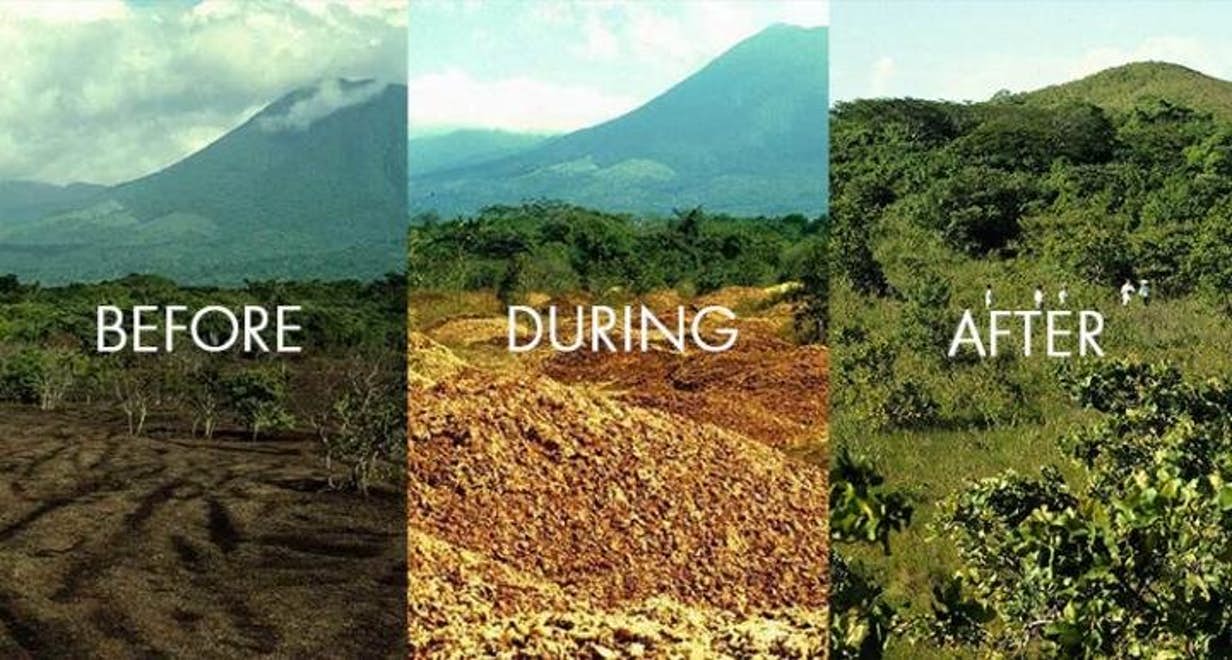
A thousand truckloads of orange peels were unloaded onto a barren pasture in a Costa Rican national park in the mid 1990s. Today, that area is covered in lush, vine-laden forest.


The land of orange peels

Forgotten for years after lawsuit.

What used to be the barren area (on the right) is now a flourishing forest, thicker, lusher and more healthy than the natural forest on the left

Proof that agricultural waste can restore decimated and barren forest land

A thousand truckloads of orange peels were unloaded onto a barren pasture in a Costa Rican national park in the mid 1990s. Today, that area is covered in lush, vine-laden forest.
Credit: Photos courtesy of Daniel Janzen and Winnie Hallwachs
A team led by Princeton University researchers surveyed the land 16 years after the orange peels were deposited. They found a 176 percent increase in aboveground biomass -- or the wood in the trees -- within the 3-hectare area (7 acres) studied. Their results are published in the journal Restoration Ecology.
This story, which involves a contentious lawsuit, showcases the unique power of agricultural waste to not only regenerate a forest but also to sequester a significant amount of carbon at no cost.
"This is one of the only instances I've ever heard of where you can have cost-negative carbon sequestration," said Timothy Treuer, co-lead author of the study and a graduate student in Princeton's Department of Ecology and Evolutionary Biology. "It's not just a win-win between the company and the local park -- it's a win for everyone."
The original idea was sparked by husband-wife team Daniel Janzen and Winnie Hallwachs, both ecologists at the University of Pennsylvania, who worked as researchers and technical advisers for many years at Área de Conservación Guanacaste (ACG, Guanacaste Conservation Area) in Costa Rica. Janzen and Hallwachs have focused the latter half of their careers on ensuring a future for endangered tropical forest ecosystems.
In 1997, Janzen and Hallwachs presented an attractive deal to Del Oro, an orange juice manufacturer that had just begun production along the northern border of Área de Conservación Guanacaste. If Del Oro would donate part of their forested land to the Área de Conservación Guanacaste, the company could deposit its orange peel waste for biodegradation, at no cost, on degraded land within the park.
But a year after the contract was signed -- during which time 12,000 metric tons of orange peels were unloaded onto the degraded land -- TicoFruit, a rival company, sued, arguing the company had "defiled a national park." The rival company won the case in front of Costa Rica's Supreme Court, and the orange-peel-covered land was largely overlooked for the next 15 years.
In the summer of 2013, Treuer was discussing potential research avenues with Janzen when they discussed the site in Costa Rica. Janzen said that, while taxonomists (biologists who classify organisms) had visited the area, no one had really done a thorough evaluation. So, while on another research trip to Costa Rica, Treuer decided to stop by the site to see what had changed over the past decade.
"It was so completely overgrown with trees and vines that I couldn't even see the 7-foot-long sign with bright yellow lettering marking the site that was only a few feet from the road," Treuer said. "I knew we needed to come up with some really robust metrics to quantify exactly what was happening and to back up this eye-test, which was showing up at this place and realizing visually how stunning the difference was between fertilized and unfertilized areas."
Treuer studied the area with Jonathan Choi, who, at the time, was a senior studying ecology and evolutionary biology at Princeton. Choi turned the project into his senior thesis.
"The site was more impressive in person than I could've imagined," Choi said. "While I would walk over exposed rock and dead grass in the nearby fields, I'd have to climb through undergrowth and cut paths through walls of vines in the orange peel site itself."
The research team evaluated two sets of soil samples to determine whether the orange peels enriched the soil's nutrients. The first set of samples was collected and analyzed in 2000 by co-author Laura Shanks of Beloit College, and the second set was collected in 2014 by Choi. Shanks' data were never published, so her analysis was combined with Choi's for the purposes of this study. The samples were analyzed using different but comparable methods.
To quantify changes in vegetation structure, the researchers established several transects within the orange waste treatment area. These transects were 100-meter-long parallel lines throughout the forest, where all trees within 3 meters were measured and tagged. This was done to see how much growth was brought on by the orange peels. For a comparison, the researchers constructed a similar set of routes on the pasture on the other side of the road, which hadn't been covered in orange peels. They measured tree diameter and identified all species within both areas.
They found dramatic differences between the areas covered in orange peels and those that were not. The area fertilized by orange waste had richer soil, more tree biomass, greater tree-species richness and greater forest canopy closure.
This story, which involves a contentious lawsuit, showcases the unique power of agricultural waste to not only regenerate a forest but also to sequester a significant amount of carbon at no cost.
"This is one of the only instances I've ever heard of where you can have cost-negative carbon sequestration," said Timothy Treuer, co-lead author of the study and a graduate student in Princeton's Department of Ecology and Evolutionary Biology. "It's not just a win-win between the company and the local park -- it's a win for everyone."
The original idea was sparked by husband-wife team Daniel Janzen and Winnie Hallwachs, both ecologists at the University of Pennsylvania, who worked as researchers and technical advisers for many years at Área de Conservación Guanacaste (ACG, Guanacaste Conservation Area) in Costa Rica. Janzen and Hallwachs have focused the latter half of their careers on ensuring a future for endangered tropical forest ecosystems.
In 1997, Janzen and Hallwachs presented an attractive deal to Del Oro, an orange juice manufacturer that had just begun production along the northern border of Área de Conservación Guanacaste. If Del Oro would donate part of their forested land to the Área de Conservación Guanacaste, the company could deposit its orange peel waste for biodegradation, at no cost, on degraded land within the park.
In the summer of 2013, Treuer was discussing potential research avenues with Janzen when they discussed the site in Costa Rica. Janzen said that, while taxonomists (biologists who classify organisms) had visited the area, no one had really done a thorough evaluation. So, while on another research trip to Costa Rica, Treuer decided to stop by the site to see what had changed over the past decade.
"It was so completely overgrown with trees and vines that I couldn't even see the 7-foot-long sign with bright yellow lettering marking the site that was only a few feet from the road," Treuer said. "I knew we needed to come up with some really robust metrics to quantify exactly what was happening and to back up this eye-test, which was showing up at this place and realizing visually how stunning the difference was between fertilized and unfertilized areas."
"The site was more impressive in person than I could've imagined," Choi said. "While I would walk over exposed rock and dead grass in the nearby fields, I'd have to climb through undergrowth and cut paths through walls of vines in the orange peel site itself."
The research team evaluated two sets of soil samples to determine whether the orange peels enriched the soil's nutrients. The first set of samples was collected and analyzed in 2000 by co-author Laura Shanks of Beloit College, and the second set was collected in 2014 by Choi. Shanks' data were never published, so her analysis was combined with Choi's for the purposes of this study. The samples were analyzed using different but comparable methods.
To quantify changes in vegetation structure, the researchers established several transects within the orange waste treatment area. These transects were 100-meter-long parallel lines throughout the forest, where all trees within 3 meters were measured and tagged. This was done to see how much growth was brought on by the orange peels. For a comparison, the researchers constructed a similar set of routes on the pasture on the other side of the road, which hadn't been covered in orange peels. They measured tree diameter and identified all species within both areas.
They found dramatic differences between the areas covered in orange peels and those that were not. The area fertilized by orange waste had richer soil, more tree biomass, greater tree-species richness and greater forest canopy closure.
"Plenty of environmental problems are produced by companies, which, to be fair, are simply producing the things people need or want," said study co-author David Wilcove, a professor of ecology and evolutionary biology and public affairs and the Princeton Environmental Institute. "But an awful lot of those problems can be alleviated if the private sector and the environmental community work together. I'm confident we'll find many more opportunities to use the 'leftovers' from industrial food production to bring back tropical forests. That's recycling at its best."
Monday, October 23, 2017
Conversation With Koko, the talking, feeling, thinking gorilla
This program doesn’t just talk with an ape, it carries on an intimate, decades-long dialogue with her. The story documents the incredible development of a gorilla named Koko, whose learning of American Sign Language (and understanding of spoken English) gives new meaning to the ideas of animal intelligence and inter-species communication.
Ahamo 2015 Winner: Excellence in Documentary Film:
Gorillas in the wild are an endangered species. They are close relatives of ours. They think and feel and communicate. And yet we rob them of their habitat and food sources, hunt them and kill them.
Thursday, October 12, 2017
'War on the EPA': How Fossil Fuel Industry Executed 'Hostile Takeover' of Key Agency
Must-see Frontline details how Trump administration handed over environmental protection to oil and gas interests
As Environmental Protection Agency (EPA) administrator Scott Pruitt formally announced this week that he plans to pull the plug on the Clean Power Plan, Frontline released a documentary titled War on the EPA, which details the Trump administration's concerted effort to cater to the fossil fuel industry's demands and roll back environmental regulations.
Among those interviewed for the film are Elizabeth "Betsy" Southerland, a 30-year EPA veteran who publicly resigned this summer and, so far, is the highest-ranking former staffer to speak out against the agency's operations under Pruitt, who was appointed by President Donald Trump and has been a key player in the administration's war on
science.
"The atmosphere of EPA is really tense," Southerland said in the film. "What everyone is trying desperately to do is to hope against hope that their facts will change Scott Pruitt's mind—that they'll be special and they'll be able to convince the administrator not to go with whatever the industry people have asked him to do, and to give some deference to the science and engineering behind previous regulations."
Mere weeks after Southerland resigned from the agency, Pruitt announced the EPA had finalized plans to postpone a regulation she had worked on, which sought to prevent coal plants from dumping toxic chemicals in waterways. Pruitt's plans were immediately denounced by experts and conservationists, with the Center for Biological Diversity calling it "mind-bogglingly dangerous."
Rolling back that rule was just one of many moves by the Trump administration to implement an agenda that serves the coal, oil, and natural gas companies. Trump first visited EPA headquarters in late March, to sign an executive order directing the agency to rewrite the Clean Power Plan. During his speech at the agency, the president declared: "My administration is putting an end to the war on coal."
The film also features an interview with Bob Murray, CEO of Murray Energy Corporation, the largest coal company in the United States. Murray mentioned in the film that not only was he in the audience during Trump's March speech at EPA headquarters, but that the president acknowledged the coal baron when he vowed to "put our miners back to work."
"I would say that people were really devastated by that," Southerland said of Murray's attendance. "That it was considered to be, really, an open slap in our face."
"What it conveyed is, 'this is a hostile takeover.' You, the scientists and lawyers and engineers at the agency are no longer valued," added Eric Schaeffer, who led the EPA's Office of Regulatory Enforcement for five years, and resigned from the agency in 2002, to protest attempts by then-President George W. Bush's administration to weaken federal clean air policy.
Thursday, October 5, 2017
Come to Churchill ( Polar Bear Town) Manitoba in Canada
Come on this virtual journey through the realm of the polar bear (http://www.nathab.com/polar-bear-tours), as we follow the life-changing experiences of Nat Hab guests, Expedition Leaders and a WWF scientist during a trip to Churchill—the Polar Bear Capital of the World. Learn how the power of conservation travel can help protect a threatened species like polar bears for generations to come.
Learn more about Churchill Polar Bear Tours and conservation travel with Nat Hab and WWF: http://www.nathab.com/polar-bear-tours/
Learn more about Churchill Polar Bear Tours and conservation travel with Nat Hab and WWF: http://www.nathab.com/polar-bear-tours/
Wednesday, October 4, 2017
Study underway to help reduce China's air pollution and prolong life expectancy
Deadly air pollution in China has long been out of control
Chinese people suffer from a multitude of respiratory diseases
Although the government has long been aware of negative effects of air and water pollution, they have been slow to act upon the problems
Toxic water pollution from industrial and human wastes fill every waterway

Solid waste like plastics cover every shore

Children play on piles of garbage releasing toxic gases
There are currently an estimated 4.5 billion people around the world exposed to levels of particulate air pollution that are at least twice what the World Health Organization (WHO) considers safe. Yet, the impact of sustained exposure to pollution on a person's life expectancy has largely remained a vexingly unanswered question -- until now.
A study published today in the Proceedings of the National Academy of Sciences finds that a Chinese policy is unintentionally causing people in northern China to live 3.1 years less than people in the south due to air pollution concentrations that are 46 percent higher. These findings imply that every additional 10 micrograms per cubic meter of particulate matter pollution (PM10) reduces life expectancy by 0.6 years. The elevated mortality is entirely due to an increase in cardiorespiratory deaths, indicating that air pollution is the cause of reduced life expectancies to the north.
"These results greatly strengthen the case that long-term exposure to particulates air pollution causes substantial reductions in life expectancy. They indicate that particulates are the greatest current environmental risk to human health, with the impact on life expectancy in many parts of the world similar to the effects of every man, woman and child smoking cigarettes for several decades," says study co-author Michael Greenstone, the director of the Energy Policy Institute at the University of Chicago (EPIC) and the Milton Friedman Professor in Economics, the College and the Harris School. "The histories of the United States, parts of Europe, Japan and a handful of other countries teach us that air pollution can be reduced, but it requires robust policy and enforcement."
The study exploits China's Huai River policy, which provided free coal to power boilers for winter heating to people living north of the river and provided almost no resources towards heating south of the river. The policy's partial provision of heating was implemented because China did not have enough resources to provide free coal nationwide. Additionally, since migration was greatly restricted, people exposed to pollution were generally not able to migrate to less polluted areas. Together, the discrete change in policy at the river's edge and the migration restrictions provide the basis for a powerful natural experiment that offers an opportunity to isolate the impact of sustained exposure to particulates air pollution from other factors that affect health.
"Unveiling this important information helps build the case for policies that ultimately serve to improve the lives of the Chinese people and the lives of those globally who suffer from high levels of air pollution," says study co-author Maigeng Zhou, deputy director of the National Center for Chronic and Non-communicable Disease Control and Prevention of the Chinese Center for Disease Control and Prevention.
Overall, the study provides solutions to several challenges that have plagued previous research. In particular, prior studies: 1) rely on research designs that may be unlikely to isolate the causal effects of air pollution; 2) measure the effect of pollution exposure for a relatively short period of time (e.g., weekly or annually), failing to shed light on the effect of sustained exposure; 3) examine settings with much lower pollution concentrations than those currently faced by billions of people in countries, including China and India, leaving questions about their applicability unanswered; 4) measure effects on mortality rates but leave the full loss of life expectancy unanswered.
"The study's unique design provides solutions to several challenges that have been difficult to solve," says co-author Maoyong Fan, an associate professor at Ball State University. "The Huai River policy also provides a research design that can be used to explore a variety of other questions about the long-run consequences of exposure to high levels of pollution."
China has increased its efforts to confront its air pollution challenge. China is switching its primary source of heating from coal-fired boilers to gas-fired or electric units, and has shut down many polluting plants. The consequence is that particulate air pollution in some of China's most polluted cities, such as Beijing, has improved significantly.
"Our findings show that these changes will bring about significant health benefits for the Chinese people in the long run," says co-author Guojun He, an assistant professor at The Hong Kong University of Science and Technology. "If all of China were brought into compliance with its Class I standards, more than 3.7 billion life-years will be saved."
China has increased its efforts to confront its air pollution challenge. China is switching its primary source of heating from coal-fired boilers to gas-fired or electric units, and has shut down many polluting plants. The consequence is that particulate air pollution in some of China's most polluted cities, such as Beijing, has improved significantly.
"Our findings show that these changes will bring about significant health benefits for the Chinese people in the long run," says co-author Guojun He, an assistant professor at The Hong Kong University of Science and Technology. "If all of China were brought into compliance with its Class I standards, more than 3.7 billion life-years will be saved."
Broader Implications -- Introducing the Air Quality-Life Index (AQLI)
Importantly, the results from this paper can be generalized to quantify the number of years that air pollution reduces lifespans around the globe -- not just in China. Specifically, Greenstone and his colleagues at EPIC used the finding that an additional 10 micrograms per cubic meter of PM10 reduces life expectancy by 0.6 years to develop a new pollution index, the Air Quality-Life Index (AQLI). The index allows users to better understand the impact of air pollution on their lives by calculating how much longer they would live if the pollution in the air they breathe were brought into compliance with national or WHO standards.
"The AQLI uses the critical data and information gathered from our China research and applies it to every country, allowing the billions of people around the world who are exposed to high air pollution levels to estimate how much longer they would live if they breathed cleaner air," says Greenstone.
Do we want our kids to live longer?? All the scientific evidence and the scientific answers are right in front of us. This requires a global effort. Air and water pollution from other countries affects us just as much as our own. Winds and ocean currents carry it to us and seriously affect our quality of life, our wildlife and aquatic life. Only by cooperation, not isolation, can we mend our damaged planet.
Friday, September 29, 2017
Wednesday, September 27, 2017
Energy can be harvested from evaporation from lakes and rivers and could potentially power much of US ....New Study

The southern and western United States have the greatest capacity to produce evaporation-generated power from lakes and reservoirs, a new study in Nature Communications finds.
Credit: Columbia University
In the first evaluation of evaporation as a renewable energy source, researchers at Columbia University find that U.S. lakes and reservoirs could generate 325 gigawatts of power, nearly 70 percent of what the United States currently produces.
Though still limited to experiments in the lab, evaporation-harvested power could in principle be made on demand, day or night, overcoming the intermittency problems plaguing solar and wind energy. The researchers' calculations are outlined in the Sept. issue of Nature Communications.
"We have the technology to harness energy from wind, water and the sun, but evaporation is just as powerful," says the study's senior author Ozgur Sahin, a biophysicist at Columbia. "We can now put a number on its potential."
Evaporation is nature's way of cycling water between land and air. Sahin has previously shown how this basic process can be exploited to do work. One machine developed in his lab, the so-called Evaporation Engine, controls humidity with a shutter that opens and closes, prompting bacterial spores to expand and contract. The spores' contractions are transferred to a generator that makes electricity. The current study was designed to test how much power this process could theoretically produce.
One benefit of evaporation is that it can be generated only when needed. Solar and wind power, by contrast, require batteries to supply power when the sun isn't shining and wind isn't blowing. Batteries are also expensive and require toxic materials to manufacture.
"Evaporation comes with a natural battery," said study lead author, Ahmet-Hamdi Cavusoglu, a graduate student at Columbia. "You can make it your main source of power and draw on solar and wind when they're available." Evaporation technology can also save water. In the study, researchers estimate that half of the water that evaporates naturally from lakes and reservoirs into the atmosphere could be saved during the energy-harvesting process. In their model, that came to 25 trillion gallons a year, or about a fifth of the water Americans consume.
States with growing populations and sunnier weather can best capitalize on evaporation's capacity to generate power and reduce water waste, in part because evaporation packs more energy in warm and dry conditions, the researchers say. Drought-prone California, Nevada and Arizona could benefit most.
The researchers simplified their model in several ways to test evaporation's potential. They limited their calculations to the United States, where weather station data are readily accessible, and excluded prime locations such as farmland, rivers, the Great Lakes, and coastlines, to limit errors associated with modeling more complex interactions. They also made the assumption that technology to harvest energy from evaporation efficiently is fully developed.
Klaus Lackner, a physicist at Arizona State University who was not involved in the study, expressed support for the team's findings. Lackner is developing artificial trees that draw carbon dioxide from the air, in part, by harnessing the power of evaporation.
"Evaporation has the potential to do a lot of work," he said. "It's nice to see that drying and wetting cycles can also be used to collect mechanical energy."
The researchers are working to improve the energy efficiency of their spore-studded materials and hope to eventually test their concept on a lake, reservoir, or even a greenhouse, where the technology could be used to simultaneously make power and limit water loss.
"We have the technology to harness energy from wind, water and the sun, but evaporation is just as powerful," says the study's senior author Ozgur Sahin, a biophysicist at Columbia. "We can now put a number on its potential."
Evaporation is nature's way of cycling water between land and air. Sahin has previously shown how this basic process can be exploited to do work. One machine developed in his lab, the so-called Evaporation Engine, controls humidity with a shutter that opens and closes, prompting bacterial spores to expand and contract. The spores' contractions are transferred to a generator that makes electricity. The current study was designed to test how much power this process could theoretically produce.
One benefit of evaporation is that it can be generated only when needed. Solar and wind power, by contrast, require batteries to supply power when the sun isn't shining and wind isn't blowing. Batteries are also expensive and require toxic materials to manufacture.
"Evaporation comes with a natural battery," said study lead author, Ahmet-Hamdi Cavusoglu, a graduate student at Columbia. "You can make it your main source of power and draw on solar and wind when they're available." Evaporation technology can also save water. In the study, researchers estimate that half of the water that evaporates naturally from lakes and reservoirs into the atmosphere could be saved during the energy-harvesting process. In their model, that came to 25 trillion gallons a year, or about a fifth of the water Americans consume.
The researchers simplified their model in several ways to test evaporation's potential. They limited their calculations to the United States, where weather station data are readily accessible, and excluded prime locations such as farmland, rivers, the Great Lakes, and coastlines, to limit errors associated with modeling more complex interactions. They also made the assumption that technology to harvest energy from evaporation efficiently is fully developed.
Klaus Lackner, a physicist at Arizona State University who was not involved in the study, expressed support for the team's findings. Lackner is developing artificial trees that draw carbon dioxide from the air, in part, by harnessing the power of evaporation.
"Evaporation has the potential to do a lot of work," he said. "It's nice to see that drying and wetting cycles can also be used to collect mechanical energy."
The researchers are working to improve the energy efficiency of their spore-studded materials and hope to eventually test their concept on a lake, reservoir, or even a greenhouse, where the technology could be used to simultaneously make power and limit water loss.
Sunday, September 17, 2017
The Unicorn of the sea ( Norwhals) Endangered

The narwhal looks like a cross between a whale and a unicorn with its long, spiraled tusk jutting from its head. Males most commonly have tusks, and some may even have two. The tusk, which can grow as long as 10 feet, is actually an enlarged tooth. Ongoing research by WWF collaborators indicates that the tusk has sensory capability, with up to 10 million nerve endings inside. The tusk may also play a role in the ways males exert dominance.
Narwhals spend their lives in the Arctic waters of Canada, Greenland, and Norway. The majority of the world’s narwhals winter for up to five months under the sea ice in the Baffin Bay-Davis Strait area (between Canada and western Greenland). Cracks in the ice allow them to breathe when needed, especially after dives, which can be up to a mile and a half deep. They feed mainly on Greenland halibut, along with other fish, squid and shrimp.
Narwhals have been listed as endangered since 2008. Very few laws have been proposed in attempts to protect this interesting species. In an effort to support conservation, the European Union established an import ban on tusks. Narwhals are becoming extinct for three main reasons. The primary catalyst for the series of events that have led to decrease narwhal populations is unprecedentedly rapid climate change.
Thousands of years of evolution have prepared an Arctic species like the narwhal for life on and around the sea ice. Because of climate change, this ice cover has dramatically decreased in both extent and thickness, at a rate far too quick for a species to adapt. A narwhal relies on sea ice for a place to feed and a place to take refuge—occasionally even a place to hide from predators. An additional result of climate change is the reduction in the population of the narwhal’s primary prey, the Greenland halibut.
Melting Arctic ice
Also encumbering rehabilitation efforts for the narwhal species is the increase in oil and gas development. The increased shipping of oil and gas has lead to increased shipping movement in sensitive areas. In addition to the possibility of fatal oil spills, collisions between boats and many species of marine life are certain to occur. Also, shipping, marine construction and military activities cause an increase in noise pollution. Whales, as well as many other marine species, rely heavily on sound for communication. This new interference by noise pollution can negatively affect a narwhal’s ability to find food and mates, navigate, avoid predators and take care of their young. “Man-made noise affects sea creatures like putting a bucket on your head. It cuts off the senses they need to survive. When they can’t hear, they can’t live”
Finally, hunting with modern equipment represents the most long-standing and consistent threat to narwhals throughout their habitat-range. Are Norwhals important??? Every link in the food chain is absolutely essential to the link that came before and the link that comes after it and the link after that. That food chain eventually makes it's way to humans, who consider themselves at the top of the chain. When those links start disappearing one by one so does our food.
It's like this...a little fish, while eating a shrimp, gets eaten by a bigger fish, which gets eaten by a bigger fish and so on until the last fish in the line is a huge marlin which is then caught by a man and eaten. That is how the food chain works. So even the species that aren't too pretty, like the narwhals hold an important place in the survival of the life on our planet.
Thursday, September 14, 2017
Monster from the Deep

When Preeti Desai was trying to assess the damage caused by Hurricane Harvey, she accidentally stumbled upon the depths of hell.
"What the heck is this indeed", Ms Desai.
The spine-chilling monster with its thick, serpent-like body, daggered teeth and NO EYES had social media stumped - the only thing they knew was that they were never going to swim again.
Some commenters threw out the suggestion of eel and a biologist agreed, telling the BBC it was a fangtooth snake-eel.
Fangtooth snake-eel. Oh okay then, so just a mixture of all of the worst things in the world – cool.
Dr Kenneth Tighe, a biologist and eel specialist, said it could be a conger or garden eel as "all three of these species occur off Texas and have large fang-like teeth".
Ms Desai, who is a part of the Audubon Society – a non-profit group dedicated to conservation, said she was seeing how extensively Hurricane Harvey had damaged the environment when she stumbled upon the creature.
"It was completely unexpected, it's not something that you'd typically see on a beach. I thought it could be something from the deep sea that might have washed on to shore," she reported.
"My main reaction was curiosity, to figure out what the heck it was."
She also said she left the horrifying monster eel on the beach "to let nature take its course".
But, monster or not, it is a citizen of earth, obviously a predator. I have seen conger eels but never one this huge. There are hundreds of thousands of aquatic species. Any average person has only ever seen a couple of hundred. With the oceans getting more acidic and warmer, thousands of these species hover on the brink of extinction.
The rapid loss of species we are seeing today is estimated by experts to be between 1,000 and 10,000 times higher than the natural extinction rate.
These experts calculate that between 0.01 and 0.1% of all species are becoming extinct each year.
Tuesday, September 5, 2017
Weep for What We Have Done

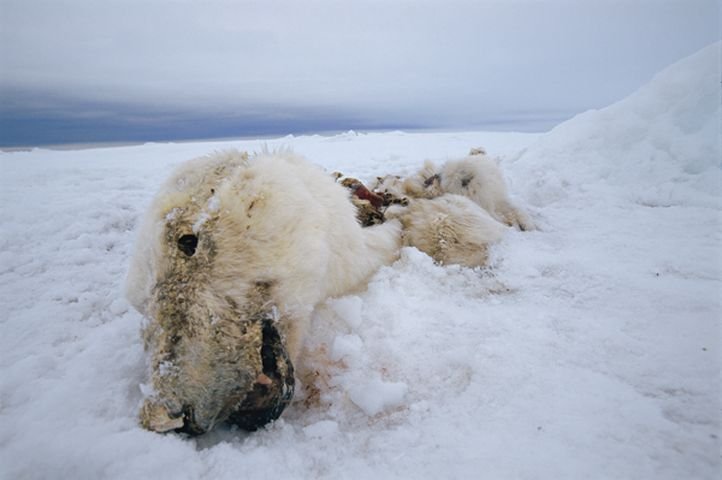



Death from exhaustion.


The Arctic Ocean is now the garbage dump at the top of the world. The ocean currents bring trash from all over the world.

It is almost too much to bear. Where do we begin??
How do we change people's thinking??
We must never give up trying.
Tuesday, August 8, 2017
A key government report on climate change has leaked. Here's what you need to know
The New York Timespublished a draft of a long-awaited government report on climate change on Monday night, and the picture it paints is dire.
Though the copy obtained by The New York Times isn't the final version, with some figures and citations still waiting to be inserted into the text, the authors' words are precise, unequivocal, and unflinching.
"Many lines of evidence demonstrate that human activities, especially emissions of greenhouse gases, are primarily responsible for the observed climate changes over the last 15 decades. There are no alternative explanations. There are no apparent natural cycles in the observational record that can explain the recent changes in climate (e.g., PAGES 2K 2013; Marcott et al. 2013). In addition, natural cycles within the Earth's climate system can only redistribute heat; they cannot be responsible for the observed increase in the overall heat content of the climate system (Church et al. 2011). Internal variability, alternative explanations, or even unknown forcing factors cannot explain the majority of the observed changes in climate (Anderson et al. 2012)."
The clear language used in the Executive Summary of the report is backed up by mountains of scientific data, and a veritable deluge of studies reports and figures that preceded this iteration. Each data point has been used to strengthen our understanding of how the climate is actively changing and warming. But the decades of investigation hasn't been easy, and the researchers who have worked on the report have faced considerable cultural opposition to their findings.
In the article accompanying the 545 page document, the New York Times mentioned that it spoke to one of the many government scientists who helped create the report. The source feared that the report would be suppressed, and requested anonymity to speak to the paper.
There is some precedent for the executive branch attempting to block reports like this, as Columbia Law professor Michael Gerrard noted on Twitter Monday night:
Congress requires the report to be submitted every four years as a part of the National Climate Assessment. The last report, published in 2014 was produced with the help of 300 climate experts overseen by a 60 member governing committee.
This draft is the fourth such report and was scheduled to be released next year. The first drafts of each of the 28 chapters in the document were gathered together in June.
Among the many findings of the report, it states that "The global, long-term, and unambiguous warming trend has continued in recent years." with 15 of the last 16 years being among the warmest on record, and the global average temperature across both land and sea rising by 1.6 degrees Fahrenheit. Much of that warming (1.2 degrees Fahrenheit) happened between 1951 and 2010, and the report says that warming was "extremely likely" to have been caused by humans.
Those temperatures are expected to rise if we continue to emit greenhouse gasses into the atmosphere, with more emissions equating to higher temperatures. Heat waves, and drenching rains are very likely to become more common around the world. Storms, droughts, and floods are also expected to increase in some regions, but in some ways, that's down to where you live. In the Arctic, the pace is faster than the rest of the world, and changes in landscape, resources, and water supplies are coming quickly.
While some aspects of climate change are extremely regional—some areas will dry out as others drown—all the regions of the world are connected in some way. Climate shifts in the Tropics or the Arctic have impacts on the United States. And not all the changes are happening on land. The vast majority of our planet is covered with water and the oceans are absorbing up to 90 percent of the excess heat that we generate. Those warming seas are rising. At the same time, those waters are absorbing carbon dioxide, becoming much more acidic.
There are some things that the report can't fully anticipate, which it readily acknowledges. These are the surprises that are littered along our future path. There are tipping points, like the collapse of ocean currents or ice sheets, which we can't put back together when they all fall apart. Then there are compound events–heat waves layered on wildfires layered on droughts, or flooding coupled with heavy rainfall all sprinkled atop sea level rise. These multi-faceted events could happen independently, or they could happen coupled with a tipping point, or two, or three, and researchers still don't have a clear picture of what the result of those deadly combinations might be.
Weather, as the report notes, examines short term change in our atmosphere, while climate is the statistics of weather. We see the weather getting weirder all the time, and according to this report, our future climate forecast is muddled, and tempestuous, and unprecedentedly hot. There is still a chance to reduce emissions, take up alternative fuel sources, or start studying geoengineering options in case we find that—in a very extreme situation—we must change the world again (on purpose this time). A less frantic climate future is not something that any one person or any one government can achieve, but it is something that anyone can work towards.
Thursday, June 8, 2017
I really hope you keep this blog going Nee. You can do so much good with it and fight back against Mr Trump's ignorance. You can inform and educate and one day you will be proud that you did. It's a most worthy cause.
Best of luck
Jeannie.
Best of luck
Jeannie.
Wednesday, May 31, 2017
Tuesday, May 23, 2017
The Legacy of the human race .... Venimus, vidimus, et destruir
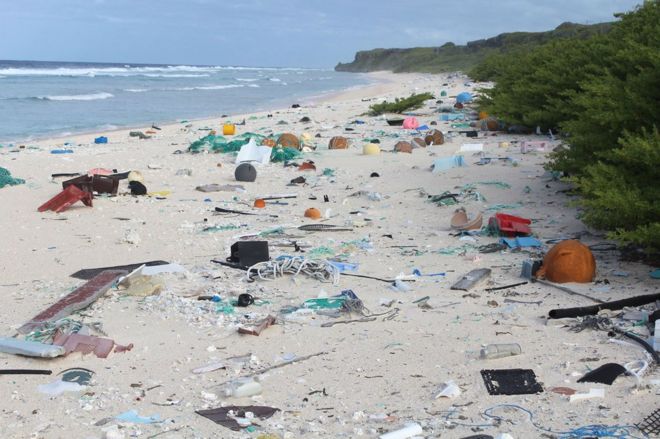
Henderson Island is part of the UK's Pitcairn Islands group
An uninhabited island in the South Pacific is littered with the highest density of plastic waste anywhere in the world, according to a study. Henderson Island, part of the UK's Pitcairn Islands group, has an estimated 37.7 million pieces of debris on its beaches.
The island is near the centre of an ocean current, meaning it collects much garbage from boats, large ships and South America. Researchers hope people will "rethink their relationship with plastic".
The joint Australian and British study said the rubbish amounted to 671 items per square meter and a total of 17 tons.
"A lot of the items on Henderson Island are what we wrongly refer to as disposable or single-use," said Dr Jennifer Lavers from the University of Tasmania.
The island is near the centre of an ocean current, meaning it collects much garbage from boats, large ships and South America. Researchers hope people will "rethink their relationship with plastic".
The joint Australian and British study said the rubbish amounted to 671 items per square meter and a total of 17 tons.
"A lot of the items on Henderson Island are what we wrongly refer to as disposable or single-use," said Dr Jennifer Lavers from the University of Tasmania.
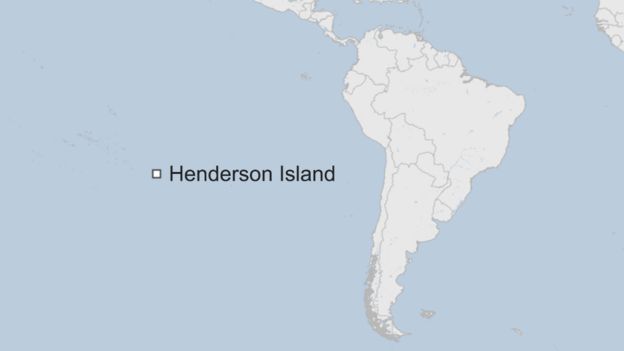
The study, published in the journal Proceedings of the National Academy of Sciences, described how remote islands act as a "sink" for the world's rubbish.
In addition to fishing items, Henderson Island was strewn with everyday things including toothbrushes, cigarette lighters and razors.
In addition to fishing items, Henderson Island was strewn with everyday things including toothbrushes, cigarette lighters and razors.

Could plastic roads help to save the planet? It is one solution being studied.
"Land crabs are making their homes inside bottle caps, containers and jars," Dr Lavers said.
"At first it looks a little bit cute, but it's not. This plastic is old, it's sharp, it's brittle and toxic." Aquatic animals are being put at high risk from the toxins in our garbage, even though they are attempting to adapt to it.
A large number of hard hats of "every shape, color and size" were also discovered, the marine scientist said.
Henderson Island is listed by Unesco as a coral atoll with a relatively unique ecology, notable for 10 rare plant and four bird species.
It is 190km (120 miles) from Pitcairn Island, about 5,000km from Chile, and sits near the centre of the South Pacific Gyre - a massive rotating current.
"At first it looks a little bit cute, but it's not. This plastic is old, it's sharp, it's brittle and toxic." Aquatic animals are being put at high risk from the toxins in our garbage, even though they are attempting to adapt to it.
A large number of hard hats of "every shape, color and size" were also discovered, the marine scientist said.
Henderson Island is listed by Unesco as a coral atoll with a relatively unique ecology, notable for 10 rare plant and four bird species.
It is 190km (120 miles) from Pitcairn Island, about 5,000km from Chile, and sits near the centre of the South Pacific Gyre - a massive rotating current.
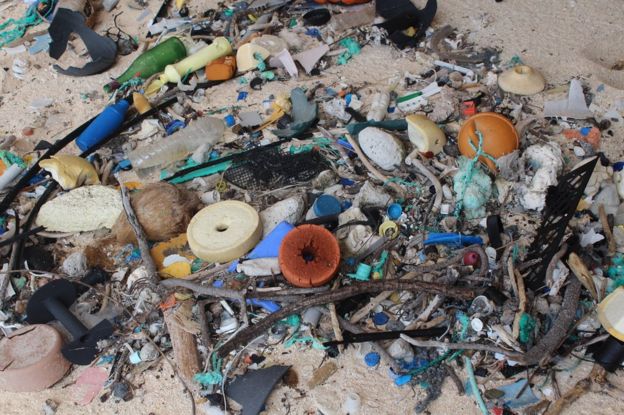
The researchers estimate the rubbish to total 37.7 million pieces
The condition of the island highlighted how plastic debris has affected the environment on a global scale, Dr Lavers said.
"Almost every island in the world and almost every species in the ocean is now being shown to be impacted one way or another by our waste," she said.
"There's not really any one person or any one country that gets a free pass on this."
She said plastic was devastating to oceans because it was buoyant and durable.
The research was conducted by the University of Tasmania's Institute for Marine and Antarctic Studies, and the Centre for Conservation Science at the Royal Society for the Protection of Birds.
"Almost every island in the world and almost every species in the ocean is now being shown to be impacted one way or another by our waste," she said.
"There's not really any one person or any one country that gets a free pass on this."
She said plastic was devastating to oceans because it was buoyant and durable.
The research was conducted by the University of Tasmania's Institute for Marine and Antarctic Studies, and the Centre for Conservation Science at the Royal Society for the Protection of Birds.
There is no longer any safe habitat for wildlife. We have poisoned every corner of the planet on land and in water and even defiled the air we need to breath. Is there any hope for our wildlife ?? Where the creatures of the earth go, we follow. If we had the ability to look two hundred years into the future, I do not think we'd recover from the shock.
Mr Trump ... Global Warming needs global co-operation

'Assailed by "enemies" on all sides, the most "unfairly" treated politician in the history of ever', (Wait ... What??) has at least had the consolation of knowing that his emissaries to the latest UN climate talks just finished in Bonn have followed his dictum to the letter. Or have they??
The Donald Trump-era perspective is that climate change is essentially an exaggerated threat, that coal, oil and gas are tremendous, and that the Paris agreement is a bad deal for America and should be "cancelled".
Given that almost all the small US delegation to Bonn were people who have previously been involved in climate discussions under the Obama administration, it must have been quite the mental u-turn to be instructed to keep repeating the mantra in climate discussions : "Our position is under review."
However, President Trump may be a little distressed to hear that instead of a stony faced resistance to the global warmist hordes in Bonn, the US team has actually been seen as playing quite a positive role.
"What we have seen, to our relief, is a generally constructive team," said Yamide Dagnet from the World Resources Institute, an observer at these talks.
"One of the US team was co-facilitator with China of the transparency discussion - this is one of the building blocks of the Paris agreement that made the most progress during this session. So we are quite pleased that there was still a constructive engagement."
The skilled negotiators from 180-plus countries involved in these talks have been doing their best to send soothing signals to Washington that everyone would be better off if the US was to stay in the game.
Fiji will become the first small island developing country to hold the presidency of the key annual meeting of negotiators, COP23, which will be held in November, again in Bonn. The woman who will lead the talks, Fijian climate ambassador Nazhat Shameem Khan, reached for an appropriate Pacific island metaphor when discussing continued US participation.
"It's very important that all members of the family stay in the canoe and that we paddle in the same direction, and that nobody jumps out," she told BBC News, without specifying the creek up which the aforementioned canoe would be travelling.
"But if they don't (stay) what are our options? The answer is we carry on with the work program and we do it with or without members of the family who have decided to bail out."
Another perhaps less subtle signal has been sent by the European Union.
It is convening a ministerial meeting next week for the first time with representatives of China and Canada to discuss climate issues.
The inference in this is that Asia, Europe and the Americas are prepared to move ahead on climate without the US. Some observers in Bonn welcomed the move.
"This is our hour of need, when we need to see other countries stepping up to ensure that the world remains on course," said Mohammed Adow from Christian Aid
"What we've heard is a clear, strong message from Europe that it is going to help cultivate the diplomatic leadership that is required to keep the world on course.
"Climate change won't wait until we have a better leader in the White House or until the White House gets serious about its commitments because we know the world is warming."
However, others were somewhat worried that overtly trying to force the issue might be the wrong approach, given the temperamental nature of the current US president.
"I think pressure may well be the wrong tactic right now," said Elliot Diringer, a Clinton-era White House press spokesman and a former member of US delegations to the UN climate talks.
"Decision-making in this White House is highly unpredictable and the president can react defensively when pushed against the wall.
"I think the better approach is to encourage the US to stay in and be as ambitious as it can be."
A decision on future US participation is likely after next week's G7 summit in Taormina,
Come on USA ! Get on the band wagon with the rest of the world. We're trying to save the planet ... not the coal and oil industries.
Subscribe to:
Posts (Atom)












